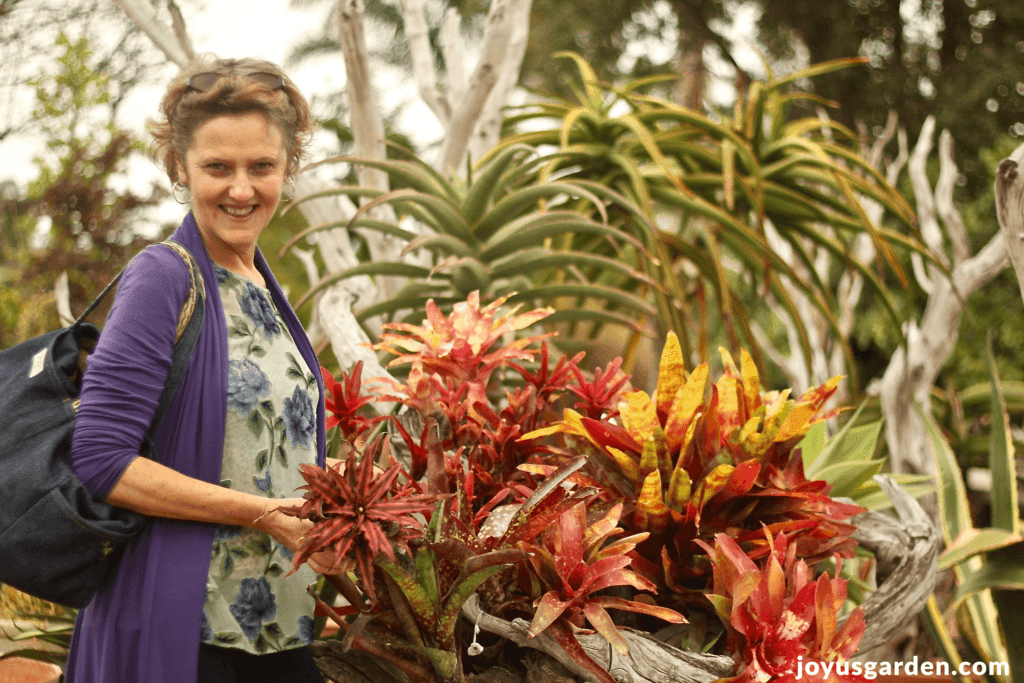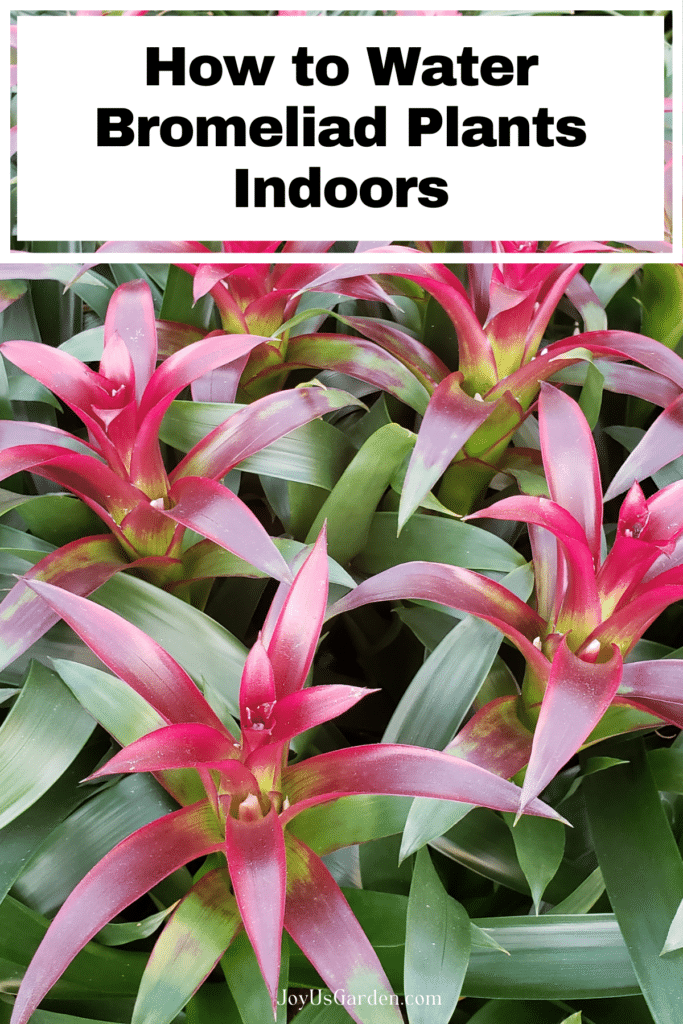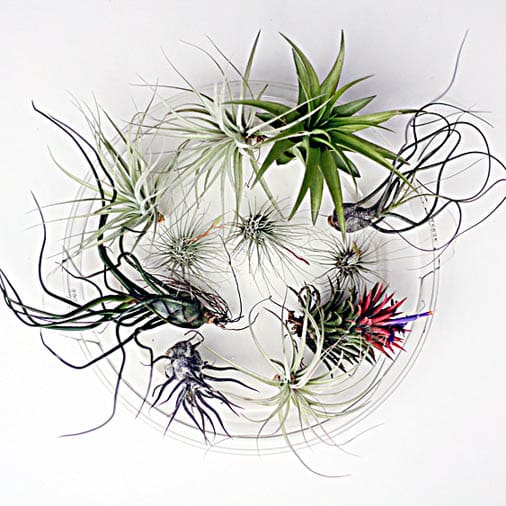Bromeliad Watering: How to Water Bromeliad Plants Indoors
A few questions have come my way about this topic, so I want to share tips for bromeliad watering, specifically, how to water bromeliad plants indoors.
I’ve been growing bromeliads for many years, both outdoors and as houseplants. They did beautifully in my Santa Barbara garden, happily growing seven blocks away from the ocean, where they relished the moisture from the coastal fog. I’ve grown them in my homes in New York City, San Francisco, and Tucson, where I currently live.
Bromeliad plants are easy to care for both indoors and outdoors. If you’re new to houseplant gardening, be sure to give one a go, and you’ll be hooked in no time. Even though these pineapple relatives are native to the tropics and subtropics, they tolerate dry air in our homes just fine.
This post may contain affiliate links, you can read our policies here.
Bromeliad Watering Indoors
Bromeliads are native to humid, rainy tropical environments. The ones I’m referring to here grow on trees, pieces of wood, and other plants. They collect nutrients and water through the center reservoir called a cup, urn, tank, or vase.
These bromeliads don’t grow in soil, and their roots serve as a means of attachment. Their shallow root systems don’t need regular watering. If you keep the keep medium soggy, yours will rot out.
Spraying / Misting Bromeliads
Because bromeliads love high humidity, misting or spraying is something they’d enjoy. Once or twice a week is fine. I spray mine in the kitchen sink or outdoors every few weeks.
In the winter months and/or if your light levels are low, simply misting or spraying the tank and the leaves every 2-4 weeks might be all your bromeliad needs regarding watering.
Air Plants are another type of bromeliad loved by many. Get Air Plant care tips here.
Best Water to Use
Of course, rainwater is best and is what they prefer. That’s not what most of us use to water our houseplants (me included), and often, tap water is fine.
Water quality can, however, play a factor. If a white ring is building up in the central tank, that indicates high mineral content.
My tap water is high in minerals. I have a tankless R/O system under my kitchen sink that remineralizes (with the good stuff!) for my drinking water. That’s what I use for watering my indoor plants.
Some people use spring or distilled water when watering their bromeliads.

Bromeliad Watering in Winter
In winter, the light levels are lower, and the air is cooler. Your houseplants, bromeliads included, will need watering less often at this time.
I water the potting medium every 4-8 weeks at this time. Instead of keeping the tank halfway full, I keep it about a quarter full.
Adjust the watering schedule/amounts to fit your home’s environment in the winter months. Keeping yours on the drier side is much better than keeping it too wet.

How to Water Bromeliads
In a nutshell, the watering routine is easy. Here’s what I do:
Bromeliads have a small root system. I run water through the planting medium, whether it be moss, bark, coir, or a bromeliad planting mix. I make sure all the excess water runs out of the drainage holes. You don’t want the base of the plant to sit in water, so make sure all has drained out before putting it back in the decorative pot and/or saucer.
I water the planting medium of my bromeliads every 4 weeks in the warmer months. In the winter, it’s every 6-8 weeks.
Summer months are very hot and dry here in the Arizona desert. I water the tanks of my bromeliads every 2-4 weeks at this time. You’ll most likely need to put water in yours less often, depending on the temperatures/humidity.
If you’re unsure of where the tank is, you can see it pictured in the image directly below.
That tank (cup, urn, or vase) is the core of the bromeliad and is usually the center of the plant. It’s how the plant collects and stores water in nature. I thoroughly flush mine out every 3-4 weeks to prevent any fungus or “funk” from building up.
After 1-3 flushes, I put a couple of tablespoons of water in the urn – just enough to keep it slightly moist in the winter. I keep it about 1/2 to 3/4 of the way full in the warmer months, and it dries out in about five days. For your bromeliads, 1/4 of the way full may be plenty, determined by your environmental conditions.
I let the water run over the leaves for 10 seconds or so. It cleans the foliage and boosts the moisture and humidity factor, at least for a few minutes!
A watering can with a long, thin neck makes it easy to get the water to where you want it to go. I also find a mister (for spraying) and a squeeze bottle (to get the water in the central tank efficiently) come in handy.
Are you interested in bromeliad care tips? This guide provides details on growing all the popular types of indoor bromeliads.


Good to Know About Watering Bromeliads
Just know it’s much better to keep bromeliads indoors on the dry side rather than consistently wet. This applies to both the soil moisture and the water in the tank. Rot will be their demise faster than you can say “Aechmea fasciata“!
You want to flush a bromeliad’s tank out because “funk” can build up there. That water is stagnant, after all. In nature, the tropical rains flush out the tanks.
If the center cup looks like it had any funk build-up from stagnant water, let it dry out for 2-7 days before putting any water back in.
Bromeliads in small pots (4″) usually need watering more often than those in 6″ or 8″ pots.
If your light levels are lower and when temps are cooler, you’ll want to keep the tank dry or almost dry. Keeping it full in these conditions can lead to rot.
In the case of the above, simply misting or spraying the tank and the leaves will probably be enough. And don’t water the planting medium too often; every 4-8 weeks should be plenty.
Your bromeliad may have pups (babies) growing off it. When they get big enough, put some water in their tanks, too.
Bromeliads are susceptible to high contents of salts and minerals in tap water. You may have to use distilled, rain, or filtered water.
Speaking of rainwater, when the monsoon season arrives here in Tucson, I put my bromeliads out to get a nice dose of fresh water. It cleans them off and thoroughly flushes the cup out, and they love the clean water. I snatch them back in before the intense summer sun comes out because they’d fry in a heartbeat.
We have a category dedicated to bromeliads. You can find articles on different types of bromeliads, propagation, planting, and flowering.
Watering Bromeliads Video Guide
Bromeliad Watering FAQs
I can’t give you an exact schedule. It depends on the size of the bromeliad and your home’s environment. Use this post as a guide and adjust. Just remember, I live in the Arizona desert. When I lived in coastal California, I didn’t water my bromeliads as often.
It’s hard to give an exact quantity. See the answer to the first question!
Yes, you sure can. Keeping the potting mix consistently wet and the tank full of water at all times will lead to rot.
They sure do! Their native habitat is the humid tropics. I mist mine once or twice a week.
If you leave them attached to the mother, the watering of the potting medium is taken care of. Once the pups get big enough, you can keep a small amount of water in their tanks.
If you separate and plant the pups in a new pot, you may have to water them a bit more often while they’re establishing.
Conclusion: There are varying opinions regarding bromeliad watering. Some camps say to keep the urn or tank full of water, some say to keep it dry, others say to water the medium every 1-2 weeks, and others say every 1-2 months.
It can be unclear if you’re new to bromeliads, so I just wanted to share what works for me. And I’m hoping it’ll work for you, too. Just remember to make adjustments for the season and your home’s environment.
Bromeliads are colorful, blooming houseplants. You can enjoy their beauty at any time of year!
Happy gardening,

Note: This post was originally published on 2/20/2018. It was updated on 11/27/2021 and 02/19/2024.
- About the Author
- Latest Posts
Nell, the founder of Joy Us garden, was born into a gardening family and grew up in Connecticut’s countryside. After living in Boston, New York, San Francisco, & Santa Barbara, she now calls the Arizona desert home. She studied horticulture & garden design, working in the field all her life. Nell is a gardener, designer, blogger, Youtube creator, & author. She’s been gardening for a very long time & wants to share what she’s learned with you.










Hi Nell. Thanks for this information. I water my bromeliad essentially the same. Good to know I’m in line with you. I would like to know how you handle the well when it flowers. I tend to use less water so it doesn’t rot. Do you agree? I also think it’s important to let newbies to bromeliads know that the plant only blooms once, but it will have a baby that will eventually flower. I had a plant for over 20 years. The plants that no longer flowered were still attractive since the leaves are so striking. You can use them as accents to other flowering plants in a grouping. Love bromeliads!
I probably should have said I live in Manteca, California. We’re in the Central Valley. Temps get down to the low 30s (at night), 40s – 50s (during the day) during the winter. As high as 110 during the summer. I leave mine outside all year, but it’s on my covered deck and protected.
I have a Bromeliad that has long variegated light & dark green leaves. The leaves are curling up. I have been misting it often but that is not helping. Is the plant dying or is there a way I can get the leaves to open flat again?
Hi Connie – You might have a Vriesea. The leaves of a bromeliad tend to curl, lighten & yellow as the mother plant is dying. It sounds like the mother plant is dying. Nell
Great information on watering techniques thankyou!
You’re very welcome Chrissie! Nell
I’m new to bromeliads. I have one that is sitting in regular potting soil. Should I repot with moss? Also, I live in central Texas where it is sunny and humid. How often would you water the urn given those conditions?
Natalie – I grow mine in a mix of orchid bark & succulent & cactus mix. If it’s flowering, don’t repot it. In your conditions, I’d keep about 1/4′ of water in the urn. You don’t want it to rot out. Nell